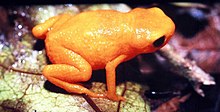| Saddleback toads | |
|---|---|

| |
| Spix's saddleback toad (Brachycephalus ephippium) | |
| Scientific classification | |
| Domain: | Eukaryota |
| Kingdom: | Animalia |
| Phylum: | Chordata |
| Class: | Amphibia |
| Order: | Anura |
| Family: | Brachycephalidae |
| Genus: | Brachycephalus Fitzinger, 1826 |
| Species | |
|
More than 35, see text
| |

| |
| Distribution of Brachycephalus (in black) | |
| Synonyms | |
| |
The saddleback toads (Brachycephalus) are a genus of tiny toads and frogs in the family Brachycephalidae in the order Anura,[1][2] ranging from south Bahia to Santa Catarina in southeastern Brazil.[3] The genus includes two main groups, the often brightly coloured pumpkin toadlets, and the overall brown and more frog-like flea frogs (or flea toads), which once were placed in their own genus Psyllophryne.[4][5] Some pumpkin toadlets are toxic and their often bright colours are considered aposematic.[6][7] At about 1 cm (0.4 in) or less in snout–to–vent length, the flea frogs are some of the smallest frogs in the world.[4][8]
The saddleback toads live among leaf litter in the Atlantic rainforest, ranging from near sea level to an altitude of 1,900 m (6,200 ft), with most species restricted to highland cloud forest.[9][10] They are mostly diurnal, feed on tiny invertebrates and breeding is by direct development, with eggs laid on land and hatching into young frogs (no tadpole stage).[11][12]
The majority of the Brachycephalus species have only been discovered in the 21st century. Most species have tiny ranges and are seriously threatened.[9]
- ^ "Brachycephalidae". Berkeley, California: AmphibiaWeb. 2020. Retrieved 2 February 2020.
- ^ Hedges, S. B.; Duellman, W. E. & Heinicke, M. P. (2008). "New World direct-developing frogs (Anura: Terrarana): Molecular phylogeny, classification, biogeography, and conservation" (PDF). Zootaxa. 1737: 1–182. doi:10.11646/zootaxa.1737.1.1.
- ^ Cite error: The named reference
Guimarães2017was invoked but never defined (see the help page). - ^ a b Cite error: The named reference
Napoli2011was invoked but never defined (see the help page). - ^ Cite error: The named reference
Monteiro2018was invoked but never defined (see the help page). - ^ Pires Jr., O.R.; A. Sebben; E.F. Schwartz; S.W. Largura; C. Bloch Jr.; R.A. Morales; C.A. Schwartz (2002). "Occurrence of tetrodotoxin and its analogues in the Brazilian frog Brachycephalus ephippium (Anura: Brachycephalidae)". Toxicon. 40 (6): 761–6. Bibcode:2002Txcn...40..761P. doi:10.1016/s0041-0101(01)00279-3. PMID 12175613.
- ^ Rebouças, R.; A.B. Carollo; M.d.O. Freitas; C. Lambertini; R.M. Nogueira dos Santos; L.F. Toledo (2019). "Conservation Status of Brachycephalus Toadlets (Anura: Brachycephalidae) from the Brazilian Atlantic Rainforest". Diversity. 55 (1): 39–47. doi:10.3390/d11090150.
- ^ Cite error: The named reference
Condez2016was invoked but never defined (see the help page). - ^ a b Bornschein, M.R.; M.R. Pie; L. Teixeira (2019). "Conservation Status of Brachycephalus Toadlets (Anura: Brachycephalidae) from the Brazilian Atlantic Rainforest". Diversity. 11 (9): 150. doi:10.3390/d11090150.
- ^ Bates, Mary (4 June 2015). "Seven New Mini-Frogs Found—Among Smallest Known". National Geographic News. Archived from the original on June 6, 2015. Retrieved 11 February 2020.
- ^ Fontoura, P.L.; L.F. Ribeiro; M.R. Pie. Haddad (2011). "Diet of Brachycephalus brunneus (Anura: Brachycephalidae) in the Atlantic Rainforest of Paraná, southern Brazil". Zoologia (Curitiba). 28 (5): 687–689. doi:10.1590/S1984-46702011000500019.
- ^ Pombal Jr., J.P.; I. Sazima; C.F.B. Haddad (1994). "Breeding Behavior of the Pumpkin Toadlet, Brachycephalus ephippium (Brachycephalidae)". Journal of Herpetology. 28 (4): 516–519. doi:10.2307/1564972. JSTOR 1564972.